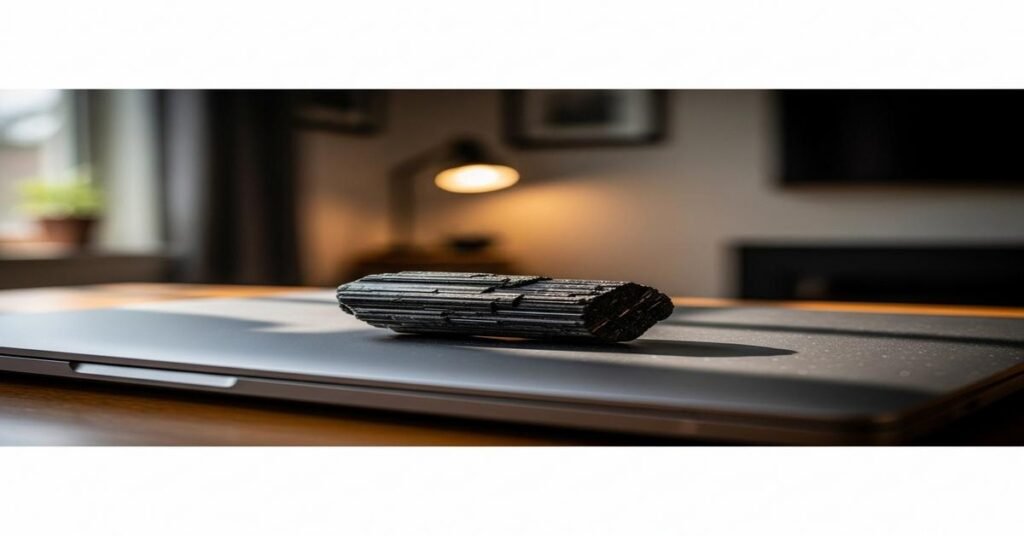People often place black tourmaline on or near laptops to “block EMF.” The idea sounds plausible: a grounding black stone that soaks up bad waves. In reality the claim doesn’t hold up to basic physics. I’ll explain what tourmaline actually does, what kinds of fields laptops emit, how real shielding works, and what small, practical steps actually lower exposure or prevent interference.
What black tourmaline is — and what it isn’t
Black tourmaline (usually the mineral schorl) is a complex borosilicate: roughly NaFe3Al6(BO3)3Si6O18(OH)4 in composition. It’s a hard mineral (about 7–7.5 on the Mohs scale) with iron-bearing crystals that look opaque black. Tourmaline is known in mineral physics for piezoelectric and pyroelectric effects — that is, when you squeeze or heat a crystal you can produce a very small voltage on its faces. That is a measured physical effect, but it’s tiny and conditional. At room temperature with an ordinary stone sitting on a desk, those effects are essentially dormant.
Important point: tourmaline is an electrical insulator, not a conductor. It will not form a conductive skin around a device. It is not ferromagnetic in the sense of attracting or redirecting low-frequency magnetic fields like the specialized magnetic alloys used in shielding.
What laptops actually emit
Laptops produce several kinds of fields:
- Low-frequency magnetic fields (ELF): created by DC and AC currents in power supplies and boards. Typical surface-level readings from laptops are in the range of 0.05–2 microtesla (μT), while Earth’s field is roughly 25–65 μT. These low-frequency magnetic fields are hard to block without heavy, high-permeability materials.
- Electric fields: from voltage on cables and casings. These are reduced by conductive, grounded surfaces (a Faraday effect for electric fields).
- Radiofrequency (RF): Wi‑Fi and Bluetooth around 2.4 GHz or 5 GHz. Signal strength is usually measured in dBm; a nearby laptop radio might be −30 to −70 dBm at short range. RF can be reduced by continuous conductive enclosures (Faraday cages) or conductive fabrics.
Why a chunk of tourmaline won’t “shield” EMF
Shielding works by either providing a conductive path to divert electric fields (Faraday shielding), or by using high-permeability magnetic materials (like mu-metal) to reroute low-frequency magnetic flux. Tourmaline is an insulator. It cannot act as a Faraday cage. It is not a high-permeability magnetic material, so it cannot appreciably redirect 50/60 Hz magnetic fields. The small pyroelectric voltage a tourmaline crystal can produce does not cancel or absorb external RF or ELF fields. In short: its material properties are the wrong ones for practical electromagnetic shielding.
What you can test yourself — a simple experiment
If you want to check, here is a straightforward test with cheap instruments:
- Use a handheld Gaussmeter to record magnetic flux density at the laptop surface (1 cm) and at 10 cm. Note baseline values in μT.
- Place a typical palm-sized schorl specimen (say 30–80 g, 40–70 mm) directly on the laptop case. Re-measure at the same points.
- Use a Wi‑Fi analyzer app on a phone to record RSSI (dBm) from your laptop’s hotspot or nearby router at 1 m. Place the stone between device and phone and re-measure.
Expected result: changes will be within the meter’s noise floor. Any small variation (1–3 dB for RF or a few hundred nT for magnetic) is likely measurement variability or slight repositioning. For meaningful shielding you would need a continuous conductive enclosure (copper or silvered fabric) for RF, or bulky high-permeability metal for low-frequency magnetic fields.
Why some people report benefits
Perceived reductions in symptoms after placing a stone can come from several non-electromagnetic effects. The stone can become a ritual or a visual cue to take breaks, change posture, or reduce screen time — all actions that reduce discomfort. A tourmaline piece can also collect dust due to static, or warm slightly in your hand; these sensory changes can be interpreted as “working,” but they are not proof of EMF attenuation.
Practical, proven ways to reduce exposure or interference
- Increase distance. EMF strength falls off quickly with distance for near-field sources. Moving a laptop even 30–60 cm away lowers exposure substantially.
- Use wired connections. Ethernet and wired peripherals remove the need for Wi‑Fi and Bluetooth radios.
- Turn off radios. Disable Wi‑Fi and Bluetooth when not needed, or use airplane mode.
- Use shielded cables and ferrites. Ferrite beads on power and USB cables reduce conducted and radiated interference. These are inexpensive and effective for RF/EMI on leads.
- Grounding and conductive barriers. A grounded conductive mat or a fully conductive case/fabric (e.g., copper or silvered nylon) provides genuine electric and RF shielding when properly implemented and grounded.
- Magnetic shielding only when necessary. For strong low-frequency magnetic fields, specialized high-permeability materials (mu-metal) are needed. These are heavy, costly, and not practical for consumer laptop placement.
Practical cautions about placing stones on laptops
Hard crystals (tourmaline ~7 Mohs) can scratch aluminum, anodized finishes, or glass. Don’t place raw specimens on screens or vents. Some polished stones can trap heat near vents and slightly raise temperatures; avoid covering cooling areas. Also expect dust attraction from static-charged crystals; that can make vents dustier, not cleaner.
Bottom line
Black tourmaline is a real mineral with small pyroelectric and piezoelectric properties. It is not a conductor or a magnetic shield. As a result it cannot meaningfully block or reduce the EMF and RF emitted by laptops. If you want measurable reduction, use distance, wired connections, ferrite beads, or properly designed conductive shields. If you enjoy having a stone on your desk for aesthetic or calming reasons, that’s fine — just don’t expect it to act as an electromagnetic shield, and avoid placing it where it can scratch or block airflow.
I am G S Sachin, a gemologist with a Diploma in Polished Diamond Grading from KGK Academy, Jaipur. I love writing about jewelry, gems, and diamonds, and I share simple, honest reviews and easy buying tips on JewellersReviews.com to help you choose pieces you’ll love with confidence.

